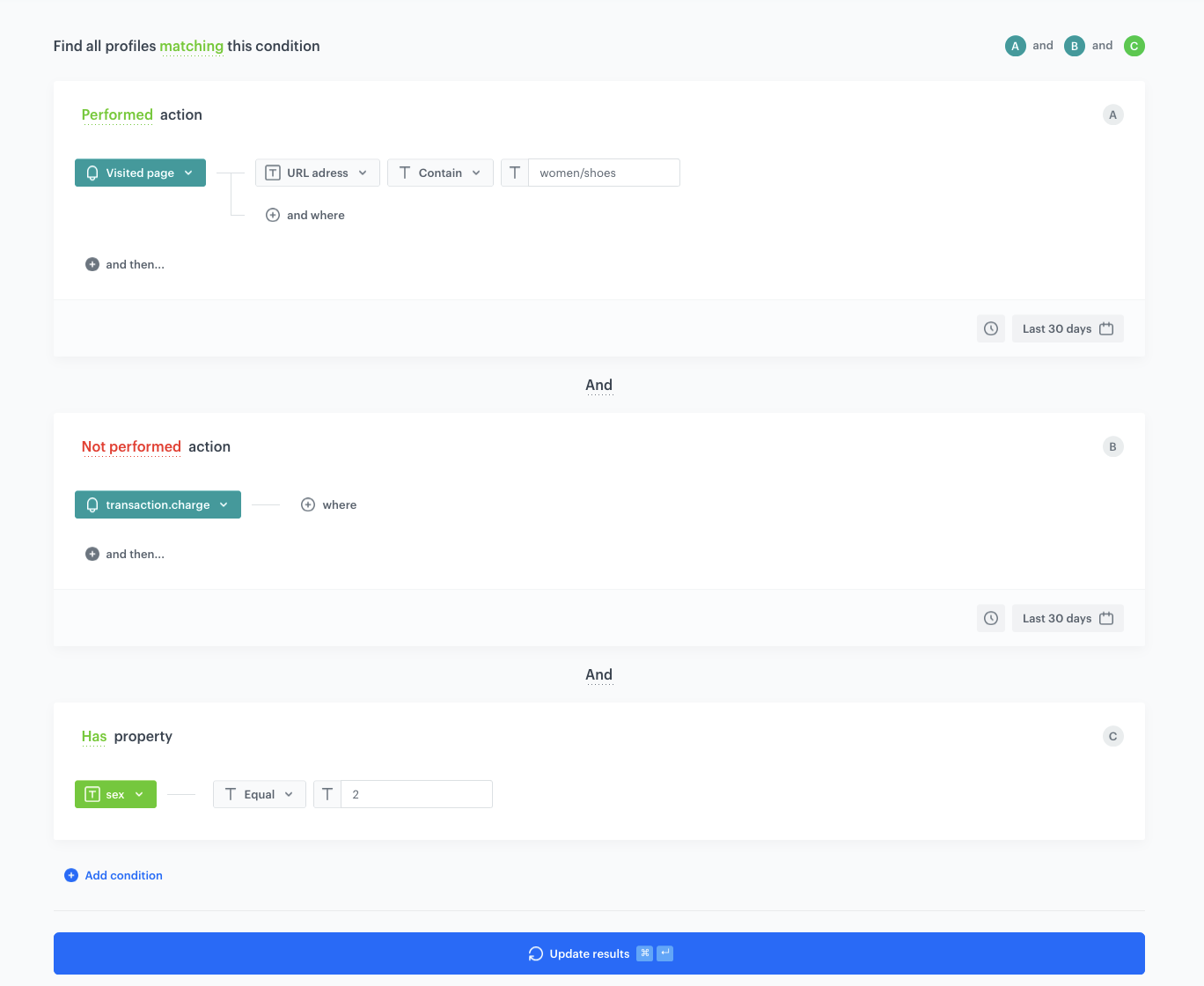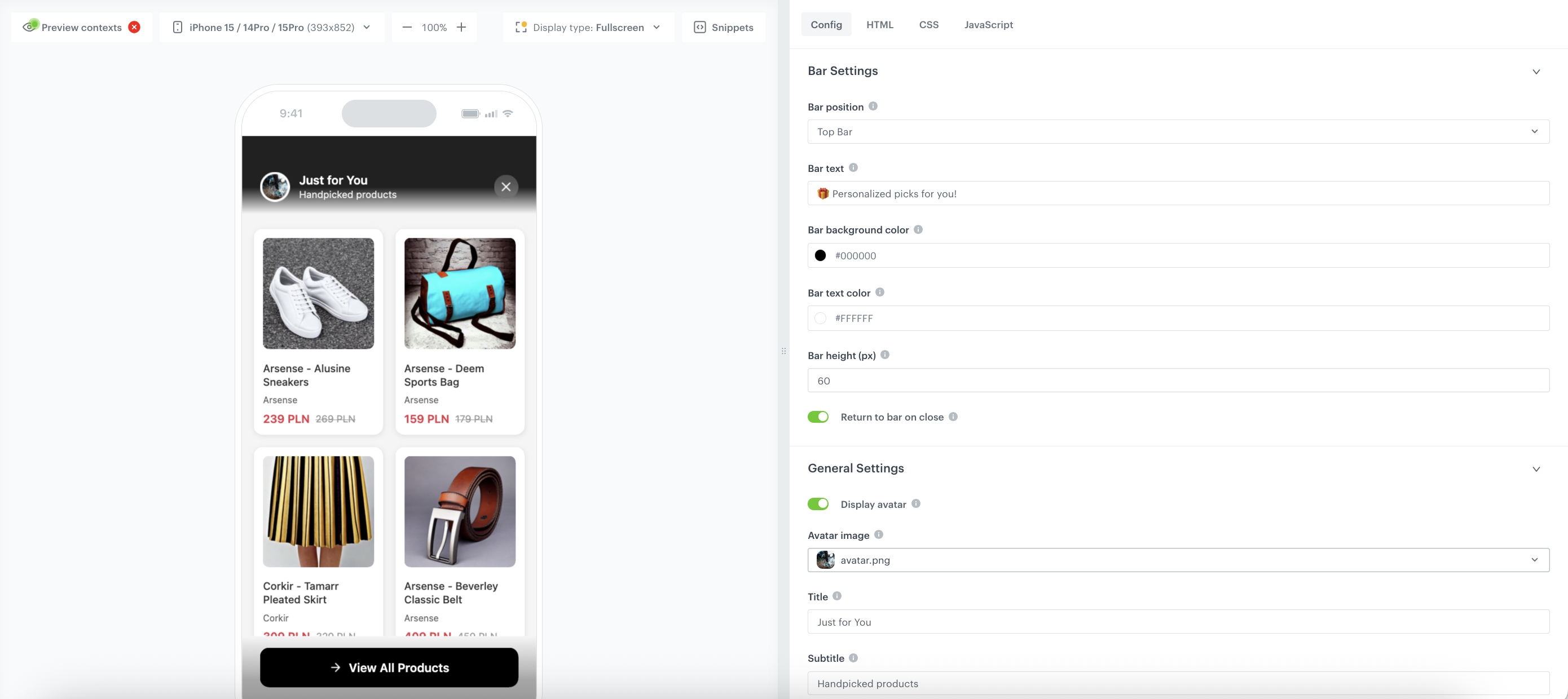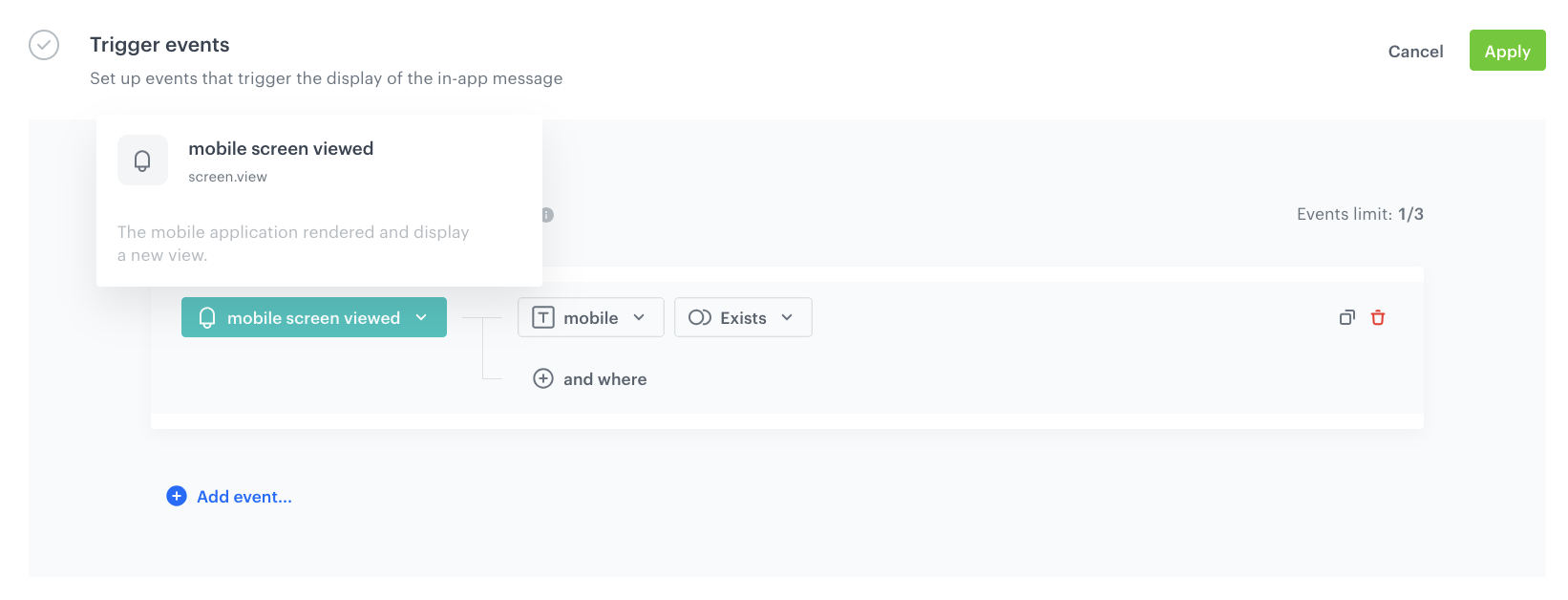In-app personalized recommendations with dynamic resize
Returning users who revisit a product category but haven’t purchased anything often face the same friction as during their first visit — large assortment, filters, and product overload. To re-engage them effectively, you can display a personalized top (or bottom) bar that appears only for this specific audience.
The bar acts as a shortcut to AI-based personalized recommendations from a category that the user viewed before, and allows them to explore those items on a personalized in-app.
This campaign will be visible only for customers who have visited the specific category during the past 30 days but have not made any purchase.
This approach works best on product or category-level pages and for users who already showed intent but didn’t complete a purchase. It combines behavioral segmentation and personalization in a single, adaptive in-app campaign.
Prerequisites
- Configure AI engine for recommendations; enable the personalized recommendation type.
- Implement the transaction events using SDK or API.
- Implement Synerise SDK in your mobile app.
Process
In this use case, you will go through the following steps:
- Prepare the segmentation of users who have visited the specific category during last 30 days but have not made a purchase from this category.
- Prepare the recommendations of personalized products from the category.
- Create an in-app campaign as a top bar which, after tapping, resizes to full screen with personalized products recommendations.
Prepare the segmentation
In this part of the process, you will create a segmentation of users who have visited the women/shoes category in the last 30 days (mobile/web) but have not made any transaction during that time.
In this part of the process, we will create a segmentation of users who have visited the women/shoes category in the last 30 days (website of mobile) but have not made any transaction during that time.
- Go to
 Analytics > Segmentations > New segmentation.
Analytics > Segmentations > New segmentation. - Enter the name of the segmentation.
- Click Add condition.
- From the dropdown list, select the
page.visitevent. - Click + where and from the dropdown list, select
url. - Choose the Contain operator and enter the fragment of the URL for the specific category. In our case it will be
women-shoes. Alternatively, you can build the following condition: category equal [category name]. - Using the date picker in the lower-right corner, set the time range to Last 30 days.
- Click Add condition.
- From the list, choose the
screen.viewevent. - Click + where and from the dropdown list, select
url. - Choose the Contain operator and enter the fragment of the URL for the specific category. In our case it will be
women-shoes. Alternatively, you can build the following condition: category equal [category name]. - Connect these conditions by the OR operator.
- Using the date picker in the lower-right corner, set the time range to Last 30 days.
- Click Add condition.
- From the list, choose the
transaction.chargeevent. - By clicking Performed above the event name change the condition to Not performed.
- Save the segmentation.

Prepare the recommendations
In this part of the process, you will prepare the personalized recommendations of products from a specific category.
-
Go to
 Communication > Recommendations > Add recommendation.
Communication > Recommendations > Add recommendation. -
Enter the name of the recommendation (it is only visible on the list of recommendations).
-
In the Type & Items feed section, click Define.
-
From the Items feed dropdown list, select an item feed that has a the Personalized model ready to use.
-
Select the Personalized recommendation type.
-
Confirm the recommendation type by clicking Apply.
-
In the Items section, click Define.
-
Click Add slot.
-
Click the Unnamed slot that was created.
-
Define the minimum and maximum number of products displayed in the frame according to your needs.
-
Define Static filters. 4. Click Define filter.
5. Select Visual Builder.
6. Click Select value. 5. Choose category. 6. As the operator, choose Equals. 7. Click the icon which appeared next to the field with the operator and from the dropdown list, select Context (eye icon). 7. As the value, choosecategory, to be sure that the category of recommended products will be the same as the category of the currently viewed item. 8. In the Category level input, select Take first subcategories. 9. In this use case, the how many levels setting is 2, but remember to adjust it to how your item feed is built. 9. In the items, choose a category. In this case:women/shoes.
Recommendation configuration -
Optionally, you can use filters to include specific items in the recommendation frame.
-
Confirm the configuration by clicking Apply.
-
Optionally, you can define the settings in the Boosting and Additional settings sections.
Create an in-app campaign
In this part of the process, you’ll use a predefined “Resize Recommendations” template that starts as a compact top bar and expands into a full screen view with personalized recommendations.
- Go to
 Communication > In-app messages> Create in-app.
Communication > In-app messages> Create in-app. - Enter the name of the in-app.
Define the audience
As the first step, define the target group of customers for the in-app message. In this case, we will use the segmentation created in the previous step.
- In the Audience section, click Define.
- Click Segmentations.
- Click Select segmentation and choose the segmentation created in the previous step.
- Save settings in the Audience section by clicking Apply.
Define content
In this part of the process, you will use a ready-made template to create the content of the in-app message that will be displayed in the mobile application.
- In the Content section, click Define.
- Click Create message and from the list of template folders, select Predefined templates.
- Select the Resize Recommendations template.
Result: You are redirected to the code editor.
You can edit the template in two ways:
- by editing the code of the template, adding inserts, adding variables
- by filling out the form on the Config tab.
In this use case, we will use the capabilities of the predefined Config tab.
Edit form in the Config tab
The form in the Config tab is already filled in with default values. You can keep them or change them to fit your business needs.

-
In the Bar settings section, set up the copy and style of the first banner. Choose the bar position (top or bottom bar).
-
In the General Settings section:
- In Title and Subtitle, define the title and subtitles for the in-app. If you don’t want to display them, enter a dash (-).
-
In the AI Recommendations section:
- Enter your AI Recommendation Campaign Hash based on the previously created campaign.
- Decide if you want to display special price and cross out regular price when available
-
In the CTA section:
- Customize the action button by defining the text on the button (Text on the button), the URL to which a user will be redirected (Destination link), colors of the button (Button text color and Button color).
-
After you complete editing the form, disable the Config mode option.
-
After you make changes to the template, you can check the preview.
- Click the Preview contexts button on the upper left side.
- Enter the ID of a customer.
- Click Apply.
Important: Considering that the in-app is very interactive, the preview in the platform may not be enough to test the in-app performance. That’s why we suggest checking the campaign preview directly in the mobile app. -
If the template is ready, in the upper right corner click Save this template > Save as.
-
On the pop-up:
- In the Template name field, enter the name of the template.
- From the Template folder dropdown list, select the folder where the template will be saved.
- Confirm by clicking Apply.
-
To continue the process of configuring the in-app campaign, click Use in communication.
-
To save your content changes, click Apply.
Select events that trigger the in-app message display
In this part of the process, you will define the event triggering the display of the in-app message. In this case, it will be visible after opening the application but - as it was specified in the campaign settings - only for a specific segment as it was set up before.
- In the Trigger events section, click Define.
- Select Add event and from the dropdown list, choose
screen.viewevent. - Click the + where button and select
source. - As the logical operator, select Equal.
- As the value add
MOBILE. - Click Apply.

Schedule the message and configure display settings
As the final part of the process, you will set the display settings of the in-app message such as schedule, capping, priority of the message among other in-app messages.
- In the Schedule section, click Define and set the time when the message will be active.
- In the Display Settings section, click Change.
- Define the Delay display, Priority index and enable the Frequency limit toggle to manage the frequency of in-app message display in the application.
- Click Apply.
- Optionally, you can define the UTM parameters and additional parameters for your in-app campaign.
- Click Activate.
Test the in-app campaign
Read the “Testing” section to discover how to test your in-app campaign.
Check the use case set up on the Synerise Demo workspace
You can check the segmentation, AI recommendations and in-app message campaign configuration directly in Synerise Demo workspace.
If you’re our partner or client, you already have automatic access to the Synerise Demo workspace (1590), where you can explore all the configured elements of this use case and copy them to your workspace.
If you’re not a partner or client yet, we encourage you to fill out the contact form to schedule a meeting with our representatives. They’ll be happy to show you how our demo works and discuss how you can apply this use case in your business.